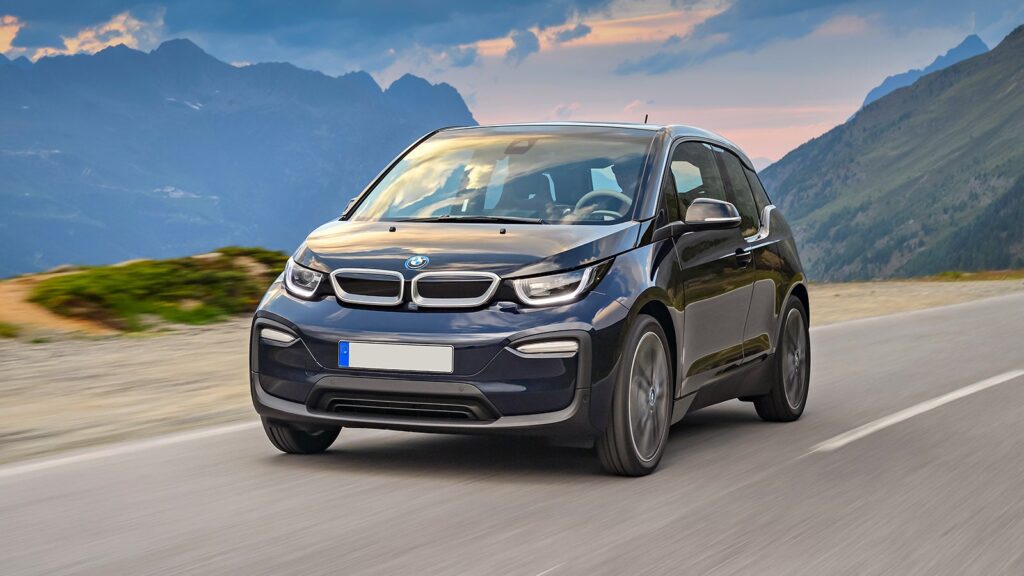Given that the BMW i3 debuted on the road more than ten years ago, it still looks and feels like a concept car—impressive.
Although BMW has long been known for its cautious and conservative designs, the Innovation BMW i3 Electric defies convention with its incredible innovation. This four-seat electric supermini has a distinctive reverse-opening rear door and a clean, minimalist interior composed of sustainable materials. With its electric motor’s rapid acceleration, the Innovation BMW i3 Electric offers thrilling performance in addition to elegance. The Innovation BMW i3 Electric raises the bar for electric transportation in the future with its flawless fusion of economy, innovation, and sustainability.
Is the BMW i3 the Right Choice for You?
First things first: if you’re a family buyer and this is your only vehicle, the BMW i3 definitely won’t be for you. It is also not the ideal option for many extended road trips. Therefore, the i3 is probably not the right automobile for you if you require practicality that is family-friendly and the capacity to drive hundreds of kilometers at a time.
However, the majority of drivers do not require that. particularly if they can recharge the i3 at home and are purchasing it as a second vehicle. In this case, you may utilize the i3 for all of your city and suburban travels and benefit from incredibly inexpensive recharging costs. The car’s cat-like agility and compact size make it simple and exciting to drive on city streets, not to mention that it can make most hot hatches look foolish.
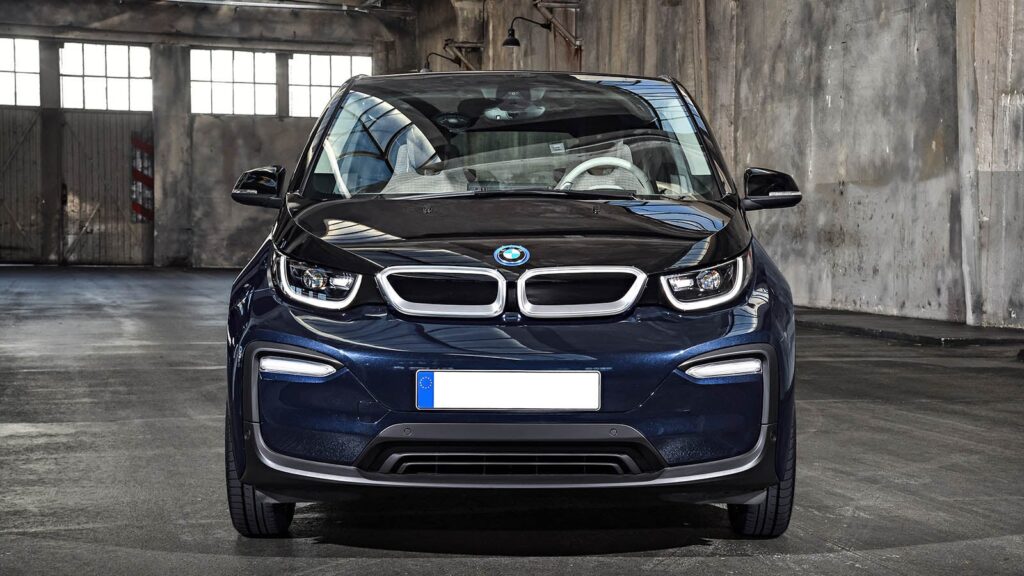
It’s a great spot to sit as well. Making the most of its electric foundations, the i3’s interior places the windscreen and passenger area well forward. Compared to most other four-meter-long superminis, this one has a stubby small bonnet and a lot more passenger room. Because it’s constructed of recycled materials, the luxurious interior upholstery feels high-end and looks contemporary without breaking the bank.
Through the door gaps, you can see the exposed carbon-fibre-reinforced polymer (CFRP) chassis. The automobile is incredibly light thanks to this ingenious building technique. This not only compensates for the weight of its battery pack, but it also enables the i3 to spin around mini-roundabouts like a ballroom dancer and take off from a stop like a frightened rabbit.
Although it won’t be for everyone, the i3 is a distinctive and endearing little vehicle. The little battery-powered BMW appeals to both the heart and the mind, although some EVs are more expensive and have larger ranges. It has strong style that is uncommon from the Bavarian automaker, and it’s enjoyable to drive, simple to use, and well-built.
Inside the BMW i3: Design and Technology
Although minimalist cabins are popular right now, BMW created the i3’s minimalist interior back in 2013. But in part because of the quirky materials utilized throughout, it nevertheless seems current. The upholstery is made of recycled plastic, while the door panels and dash are made of sustainable plant fibers.
The dashboard itself lacks the large supporting framework present in many competitors and is divided into discrete pods. The audio and climate controls include a straightforward group of tactile buttons, together with appropriate volume and cabin temperature sliders. On more expensive models, the bent strip of material behind this panel is trimmed in open-pore wood, creating a little shelf that can hold smaller objects. Beside these is an unmarked button that reveals a glovebox placed on top of the strip by opening the left section of the strip.
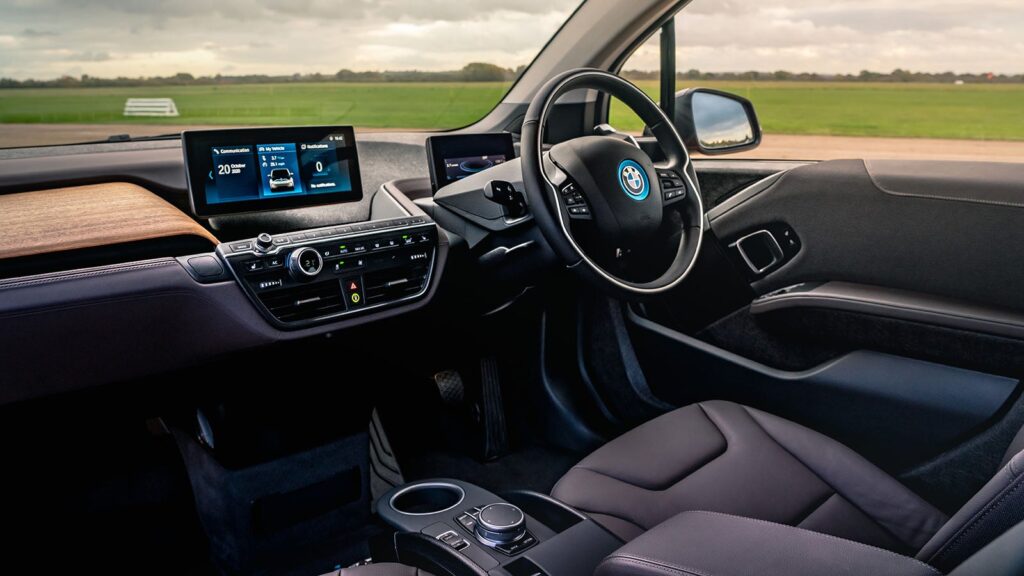
In addition to the dashboard’s ample storage for odds and ends, the i3’s electric platform eliminates the requirement for a center console between the two front seats. In addition to having an elasticated band on the firewall beneath the dash to safely keep objects stowed here, this allows room for a medium-sized purse.
The infotainment system is really the clearest indicator of the i3’s true age. When compared to the theater-like screens found in contemporary competitors, this car’s dual-screen setup—which had both digital driver’s dials and a central infotainment screen—now seems a bit modest. The primary displays of more current i3s have grown by a few inches, but the on-screen visuals are still crisp and simple to see. However, the rotary joystick on the armrest between the front seats is the sole way to manage the screen, which seems a bit archaic in this day and age of touchscreens.
BMW i3 Review: Impressive Passenger Space but Practicality Challenges in Cargo and Rear Access
The i3’s usefulness is impressive in certain ways but lacking in others.
Let’s start with the positive news. Considering that the car is shorter than an Audi A1, the passenger room is quite amazing. Large windows and a minimalist dashboard create an airy feeling and plenty of space up front. Few vehicles in this class can match the two back seats’ ample accommodation for adults, and even six-footers should have no trouble sitting behind similarly tall front-seat passengers without experiencing legroom issues.
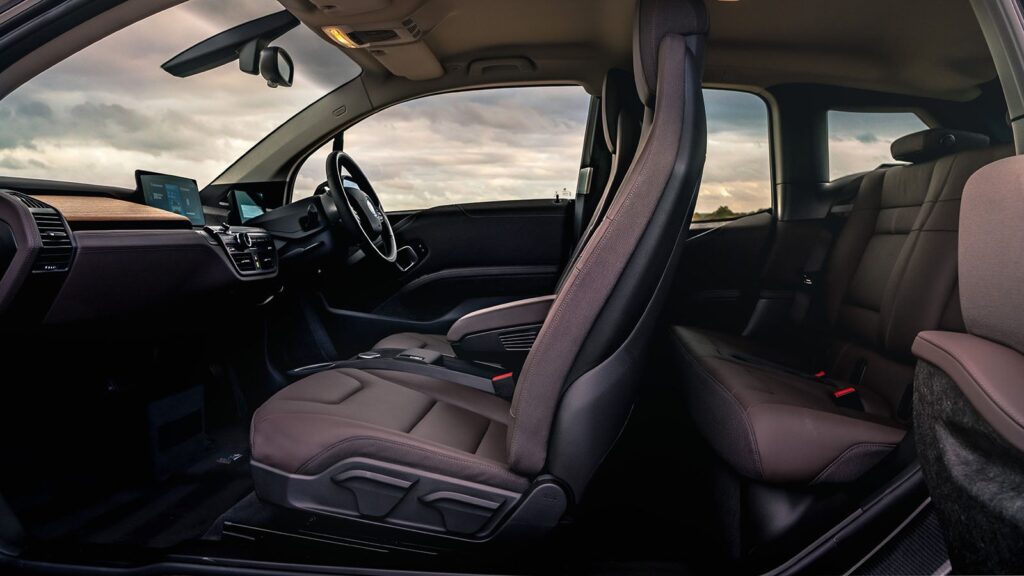
But there are disadvantages. First and foremost, the rear row only has two seats instead of the three that other superminis have. The BMW’s lack of a fifth seat isn’t a huge deal since, of course, those competitors are so little that using all three seats is actually only feasible for very brief excursions.
The car’s strange rear-opening’suicide’ back doors make it a little strange to access the back seats. These can only be opened while the front doors are open, and because that’s the only way they’ll close, you’ll need to remember to close them again before closing the front doors. You’ll still need to pull a latch on the front seats to fold them out of the way because the doors by themselves don’t offer much to increase rear-seat access. But if you get the hang of it, it’s usually easy to get to the back seats, and the large side window lets in a lot of light.
Given the car’s compact structure, the passenger capacity may be impressive, but the cargo space is a little lacking. On paper, the 260-liter trunk is smaller than most competitors’, but in reality, it seems fairly small because the electric motor takes up all of the underfloor room. At least the tall, wide boot lid makes it simple to access the small interior. Anything larger will need you to fold the back seats, but a weekly shop or a couple’s vacation bags should fit back there. Under the short bonnet of the i3, there is a little ‘frunk’ that is best used to hold charging cords.
The Development of the BMW i3 Powertrain: From Range Extenders to All-Electric Performance
Early i3 models came either as a purely electric car, or with the option of a petrol-powered ‘range extender’. This was essentially a small motorbike engine that sat under the boot floor and topped the battery pack up for longer-distance drives. It was a little grumbly in operation, however, and didn’t really extend the range much thanks to its small on-board fuel tank. As a result, the range extender wasn’t especially popular and was dropped from the lineup in 2019.
With an option of two electric motors on the back axle, it was replaced with a new 42kWh battery pack that was compatible with all i3 versions. Electric motors in standard i3 models provide 170 horsepower; the i3S variant has 184 horsepower. With this combination, the i3S’s range is around 170 miles, whereas that of regular automobiles is approximately 190 miles.
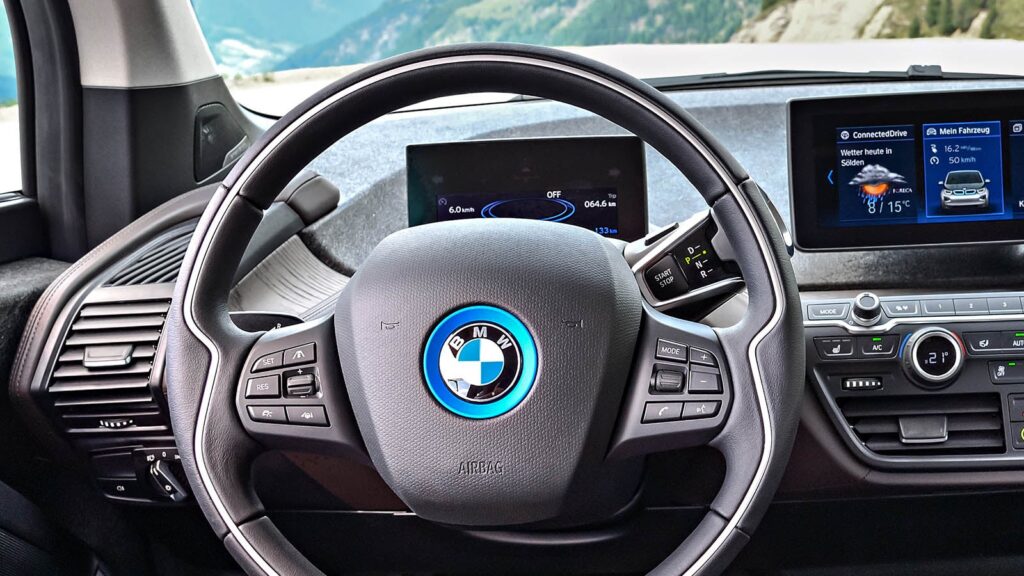
Under ideal circumstances, the i3 should be able to recover 80% of its battery in less than 40 minutes thanks to 50kW DC fast charging. It will take little more than six hours for a 7.4kW AC wallbox-style home charger to get 100% charge.
Both the stationary and city speed variants of the i3 feel incredibly fast. The electric motor’s quick reactions allow for quick acceleration without any delay caused by gearboxes or turbochargers figuring out what to do. Only when you press for a quick overtaking does that muscle reaction begin to falter. It continues to function at highway speeds.
The i3S differs from the normal i3 at higher speeds; when you’re driving close to the national speed limit, the car pulls harder. However, at lower speeds, it would be difficult to distinguish between the two, as seen by the little 0.4-second difference in their 0-62 mph timings. Therefore, we would save our money and get the base model unless you want the bragging rights and slightly sharper body kit that come with the i3S.
BMW i3 Comfort and Driving Dynamics: Perfect for City Streets, Less So for High Speeds
You can tell that the i3 or i3S is a sporty car by the significant G-force that pushes you back in your seat when you pin the throttle. You may anticipate the i3 to handle with the aggressive precision of previous vehicles with the blue-and-white logo because of this and BMW’s reputation for producing the “ultimate driving machines.” Ironically, though, the i3’s handling falls short of the remainder of the driving experience.
The i3 is easy to drive and is really in its element in town. You can confidently weave it through tight spaces and execute challenging maneuvers with ease because to its fast, light steering and incredibly tight turning circle. Here, too, the electric motor’s lightning-fast responses come in handy, enabling you to blast off from a stop and whizz along with traffic. Considering that the majority of i3s have massive alloy wheels, the suspension also has a respectable level of compliance, reducing the effect of potholes and speed bumps.
At greater speeds, the i3 isn’t quite as compelling. Because of the softer suspension system, the body occasionally seems as though it is bouncing independently of the wheels in this situation. If you round a curve too quickly, you will notice noticeable body roll. The forceful wheel spins that send the front axle diving into a corner are made worse by the abrupt steering, which also makes it difficult for the body to respond quickly enough to feel linked into the process, so it leans to the side instead. At highway speeds, there is also a discernible amount of wind noise. In sharp contrast, a Mini Hatchback, another little BMW vehicle, feels considerably more comfortable on highways with higher speeds.
Nevertheless, the i3 is still a very likable vehicle in spite of its slightly erratic handling arrangement. Its immediate point-and-squirt electric propulsion dominates the driving experience, so we’ll gladly call it enjoyable despite its slightly soupy suspension. It performs best around town, where its fast reflexes and narrow turning circle make it the ideal partner.
Conclusion
The BMW i3 is an impressive combination of innovation, sustainability, and city-friendly usability. Its tiny size, quick handling, and immediate electric propulsion make it an ideal city companion. While its range and load capacity may not be suitable for extended journeys or bigger families, the i3 shines in terms of design, comfort, and environmental friendliness. For those looking for a sleek, economical second car for city living, the i3 is a standout and satisfying option.
Related Post : Rivian 2025 R1S Adventure: Enhanced Performance, Smarter Design, and Exceptional Features


